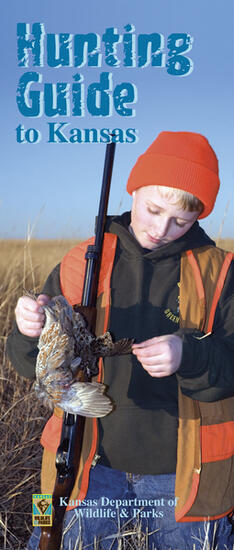About Kansas Hunting
Hunting in Kansas
Hunting in Kansas can be described with one word: variety. From east to west, north to south, Kansas has a rich and diverse array of habitat and game species. The hunting heritage runs deep in Kansas, and hunting is important to the quality of life and rural economies. Unique hunting opportunities wait on the eastern and western borders, and the central region provides a blend.
The physiographic regions of the state, distinguished by climatic, topographic and vegetative differences, allow such variety.
Generally, Kansas' climate is wetter in the east than the west. In fact, the southeast region may receive 40 inches of rain per year, whereas the southwest region may receive less than 15. Being familiar with the physiographic regions can help a hunter select an area of the state to correspond with the preferred type of game, as well as the style of hunting desired.
In the northcentral part of the state, the Smoky Hills follow the Smoky Hill River to the east. The Smoky Hills region is characterized by vast areas of rolling grassland and some dramatic topography. The land is farmed along the river bottoms, and this combination of permanent native cover and agriculture provides pheasant, quail, prairie chicken, turkey, and deer hunting opportunities.
The far northeastern corner of the state is the Glaciated Region. This region features gently rolling plains with broad stream valleys. It is characterized by heavily timbered, rocky hillsides and small irregular croplands. This region provides excellent deer and turkey hunting, as well as bobwhite quail, rabbit, and squirrel opportunities.
The High Plains, the western one-third of the state, is the largest and driest region. Originally shortgrass prairie and nearly treeless, most of the High Plains has seen dramatic changes due to settlement and agriculture. Many areas of the High Plains are intensively farmed, and this combination of native grass and agriculture makes this region ideal for ring-necked pheasants. The High Plains are wide open and vast.
Where untilled, native shortgrasses, yucca, sagebrush and other arid-climate vegetation support lesser prairie chickens. Antelope still inhabit the far western reaches of this region and provide limited hunting opportunities. Mule deer thrive in the region, although you also find whitetails. The Conservation Reserve Program has returned thousands of acres in this region to native grasses.
The north-south strip of grassland through the east-central portion of the state is known as the Flint Hills. Much of this region remains in native grass because a layer of rock just beneath the soil's surface prevents tillage. Vast areas of unbroken tallgrass prairie with timbered, brushy draws and streambottoms make this unique area ideal for quail, deer, and turkey, and it remains the nation's stronghold for the greater prairie chicken.
In the center of the state are the Wellington and McPherson Lowlands. These regions are characterized by several wetlands and salt marshes and form the transition zone between the west and the Flint Hills. Much of the region is intensively farmed. The combination of wetland, prairie, and croplands provides a variety of game species for hunters, from upland birds to deer, turkey, and small game. And during wet years, the wetlands and flooded croplands attract untold numbers of waterfowl.
In the southwest, the Arkansas River Lowlands follow the river from the Colorado border, east to Wichita, then south to Oklahoma. Sand and sediment carried by the river have formed sandhill grasslands along this corridor, and this area provides ideal lesser prairie chicken habitat. This midgrass prairie is dotted with sandhill plum thickets and eastern redcedars, and provides good quail, pheasant, deer and turkey hunting.
In the southcentral region, the beautiful Red Hills bring topographic relief to the land. The Red Hills are largely native grassland with bluffs, buttes and steep draws and canyons filled with cedars, sumac and sandhill plum thickets. Timbered areas follow the many spring-fed creeks and streams throughout the region. This area is known for bobwhite quail, turkey and deer hunting.
The Osage Cuestas dominate the southeastern one-quarter of the state. Rolling grasslands, limestone bluffs, and heavily timbered bottomlands mark this region. The hardwood timber provides excellent deer, squirrel, and eastern turkey hunting. Quail hunting can also be very good on the grasslands and at the edges of timber, grass, and small crop fields.
At the southern reaches of the southeastern quarter are the Chautauqua Hills. Rolling tallgrass prairie is dotted with thickly timbered bottoms and draws. Underlying sandstone protects the grasslands, and the croplands are restricted to streambottoms. The region provides excellent deer, turkey and quail hunting.
The Cherokee Lowlands distinguish the southeastern corner with thick brush and timber, and rich coal resources. In recent years, thousands of acres, once strip mined for coal, have been reclaimed to native vegetation. The Mined Land Wildlife area was donated to the department for public use. The area provides deer, quail, squirrel, rabbit and turkey hunting, as well as fishing in the hundreds of strip mine lakes.
In the far southeast lies the Ozark Plateau. This is the wettest region of the state, receiving more than 40 inches of rain annually. Heavy timber, dissected by streams and broken with small cropfields, make this area ideal for deer, turkey, squirrel, and rabbit hunting. Bobwhite quail are found on the edge areas between timber, grass, and croplands.











